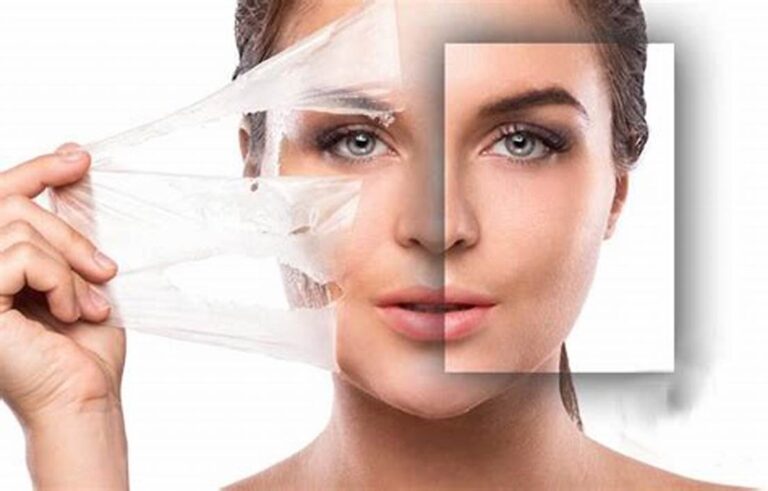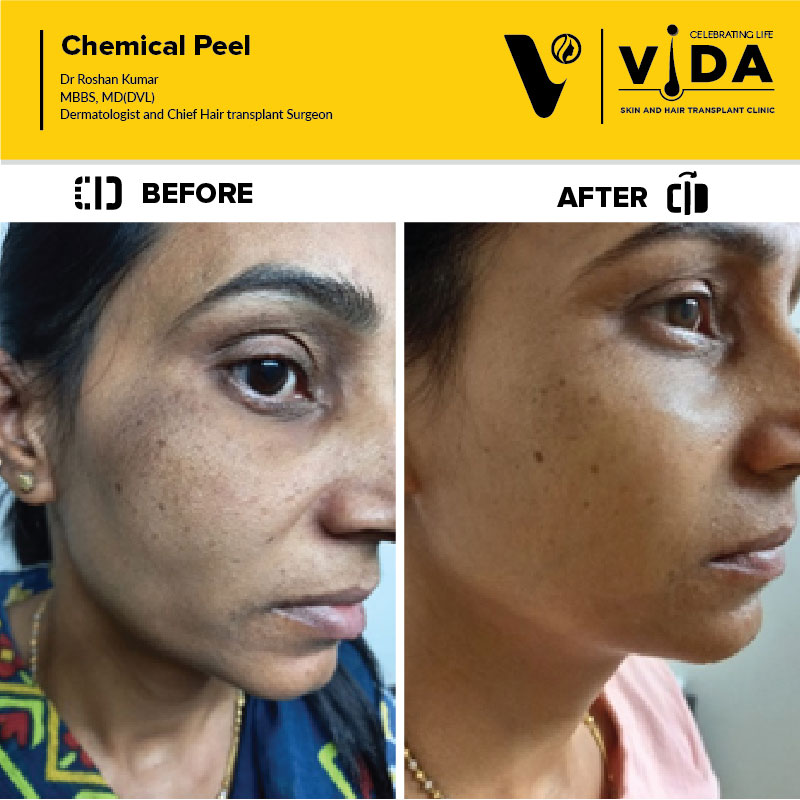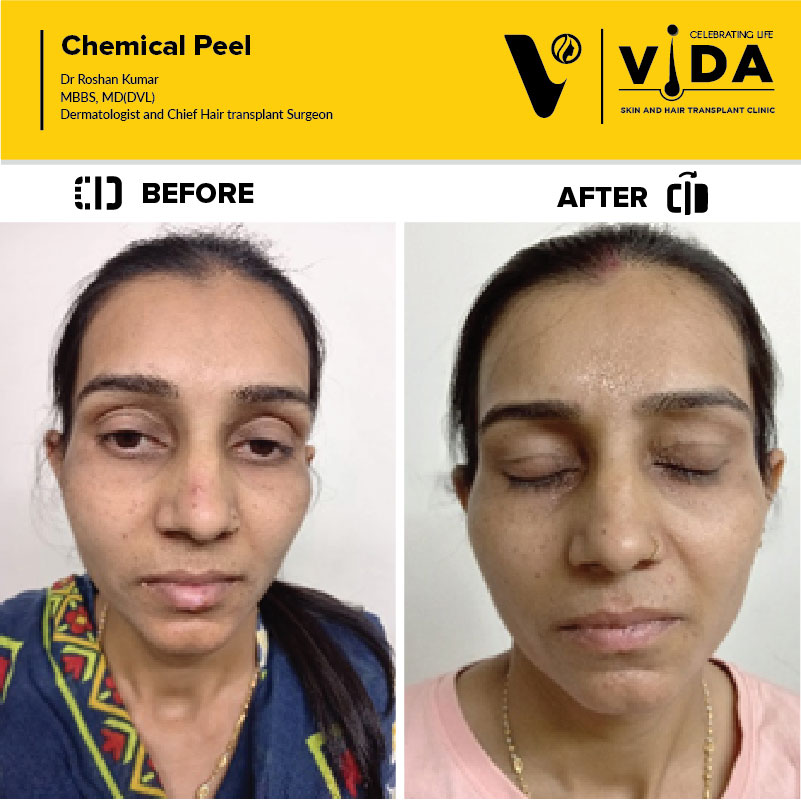Get personalized Consultation!
Chemical Peel


Chemical peels have long been a popular skincare treatment for individuals seeking rejuvenation and improvement of their skin’s overall appearance. In this article, we will dive deep into the world of chemical peels at Vida Skin and Hair Transplant Clinic, exploring the historical context, understanding the different types of peels, their benefits, the process involved, recovery period, and even the potential risks and side effects. So, if you’re considering a chemical peel, keep reading to discover everything you need to know.
Definition of Chemical Peel
A chemical peel is a non-surgical cosmetic procedure that involves the application of a chemical solution to the skin, which essentially exfoliates and peels off the top layer, revealing new, healthier skin underneath. It is an effective treatment for various skin conditions, such as acne scars, hyperpigmentation, fine lines, and wrinkles.
Historical Context of Chemical Peels
Chemical peels have a rich historical context dating back centuries. Ancient civilizations, such as the Egyptians and Greeks, were known to use chemical substances, including sour milk and fruit acids, to improve their skin’s appearance. Throughout the years, advancements in medicine and skincare have led to the development of more sophisticated chemical peel formulas and techniques, making them safer and more effective.
Importance of Skincare in the Modern Era
In today’s image-conscious society, maintaining healthy and youthful-looking skin has become increasingly important. The modern era places great emphasis on self-care and well-being, with individuals seeking treatments and procedures that can help them achieve their aesthetic goals. Skincare has become an essential aspect of everyone’s routine, as it not only enhances our physical appearance but also boosts our confidence and self-esteem.
Understanding Chemical Peels
To fully grasp the potential benefits and implications of a chemical peel, it is essential to understand the different types of peels available and how they work.
Types of Chemical Peels
- Superficial Peels: These are the mildest type of chemical peels, targeting only the outermost layer of the skin (epidermis). They are typically made of alpha-hydroxy acids (AHAs) or beta-hydroxy acids (BHAs), such as glycolic acid or salicylic acid. Superficial peels are suitable for individuals with mild skin concerns, such as uneven texture or tone.
- Medium Peels: Medium peels penetrate deeper into the skin, reaching the middle layer (dermis). They are usually composed of trichloroacetic acid (TCA) and are effective in treating moderate wrinkles, pigmentation issues, and acne scars.
- Deep Peels: Deep peels are the most intensive form of chemical peels, reaching the deepest layer of the skin. They are often performed using phenol, providing significant and long-lasting results for severe wrinkles, sun damage, and deep scars. It is important to note that deep peels require careful consideration and should only be performed by experienced professionals.
How Chemical Peels Work
Chemical peels work through a process known as exfoliation and the stimulation of collagen production.
Exfoliation Process
During a chemical peel, the application of the chemical solution causes controlled damage to the outermost layer of the skin. As the damaged skin naturally begins to slough off, it reveals the fresh, rejuvenated skin underneath. This exfoliation process eliminates dead skin cells, unclogs pores, and encourages the growth of new cells.
Stimulation of Collagen Production
Collagen is a protein responsible for maintaining the skin’s structure and elasticity. Chemical peels stimulate the production of collagen, which helps improve the overall texture and firmness of the skin. With increased collagen production, fine lines and wrinkles are reduced, further contributing to a more youthful appearance.


Benefits of Chemical Peels
Chemical peels offer a range of benefits that can greatly enhance the appearance and health of your skin. Let’s explore some of the key advantages of undergoing this treatment at Vida Skin and Hair Transplant Clinic.
Skin Rejuvenation
One of the primary benefits of a chemical peel is skin rejuvenation. By removing the damaged outer layer of the skin, a fresh and youthful complexion is revealed. The exfoliation process also helps to improve skin tone, texture, and overall radiance.
Reduction of Fine Lines and Wrinkles
Fine lines and wrinkles are a natural part of aging, but they can significantly impact our confidence. Chemical peels effectively target these signs of aging by reducing the appearance of fine lines and wrinkles, particularly in the treated areas. With a smoother and more youthful complexion, individuals often experience a boost in self-esteem.
Treatment of Acne Scars
Acne scars can be a persistent reminder of past skin issues, affecting both the appearance and self-confidence of those who have them. Chemical peels can dramatically reduce the visibility of acne scars, helping individuals achieve clearer and more even-toned skin.
Hyperpigmentation Correction
Hyperpigmentation, characterized by dark spots or patches on the skin, can be a result of sun damage, hormonal changes, or acne scarring. Chemical peels work effectively to correct hyperpigmentation, reducing the appearance of uneven skin tone and creating a more balanced complexion.
Improvement of Skin Texture
Uneven texture, roughness, and dullness can hinder the overall appearance of the skin. Chemical peels help improve skin texture by removing dead skin cells and stimulating collagen production, resulting in a smoother and more refined complexion.
Choosing the Right Chemical Peel
Before undergoing a chemical peel, it is essential to consider various factors to ensure you choose the most suitable treatment for your skin.
Skin Type Considerations
Different skin types have unique needs and sensitivities. It is crucial to consult with a skincare professional at Vida Skin and Hair Transplant Clinic to determine which type of chemical peel is best suited for your skin. Factors such as sensitivity, oiliness, or dryness should be taken into account to avoid any adverse reactions.
Consultation with a Dermatologist
A consultation with a dermatologist or skincare expert is highly recommended before undergoing a chemical peel. This consultation allows the professional to assess your skin condition, discuss your skincare goals, and determine the most appropriate treatment plan for.
Understanding Ingredients in Chemical Peels
Chemical peels are formulated with various active ingredients, each with its own benefits and potential side effects. Understanding the ingredients used in chemical peels can help you make an informed decision and ensure the peel aligns with your skincare goals.
Preparing for a Chemical Peel
Proper preparation is crucial to ensure optimal results and reduce the risk of complications. Consider the following steps before undergoing a chemical peel:
Pre-peel Skincare Routine
Following a pre-peel skincare routine recommended by your dermatologist or skincare professional can significantly enhance your chemical peel experience. This may involve avoiding specific skincare products or medications that can interfere with the effectiveness of the peel or cause adverse reactions.
Avoiding Sun Exposure
Exposure to the sun’s harmful UV rays can increase the risk of complications after a chemical peel and hinder the healing process. It is essential to protect your skin from the sun by wearing sunscreen, protective clothing, and avoiding prolonged sun exposure in the weeks leading up to your chemical peel.
Managing Expectations
Managing your expectations is vital when undergoing a chemical peel. While chemical peels can provide remarkable results, it is essential to understand that the extent of improvement and recovery time may vary depending on individual factors, such as skin type and the depth of peel chosen.
The Chemical Peel Process
The actual chemical peel process typically involves several steps, from the initial consultation to post-peel care instructions. Here is a breakdown of what you can expect during the process:
Consultation and Skin Assessment
Before undergoing a chemical peel at Vida Skin and Hair Transplant Clinic, a thorough consultation will be conducted. During this consultation, a skincare professional or dermatologist will assess your skin condition, discuss your desired outcomes, and determine the most suitable type of peel for your specific needs.
Application of the Chemical Solution
Once the consultation is complete and the appropriate chemical peel is selected, the next step involves the application of the chemical solution on the targeted areas of your skin. The solution will be carefully and evenly applied to ensure an optimal outcome.
Sensation During the Peel
During the chemical peel process, you may experience mild tingling or a warm sensation on your skin. Depending on the depth of the peel, you may also experience a temporary burning or stinging sensation. However, discomfort is typically minimal and well-tolerated by most individuals.
Post-Peel Care Instructions
After your chemical peel, your skincare professional will provide you with detailed post-peel care instructions. Following these instructions is crucial for optimal healing and to minimize the risks of complications. This may include a specific skincare routine, avoiding direct sun exposure, and using recommended moisturizers or serums.
Recovery Period
Understanding the recovery period after a chemical peel is essential to properly manage expectations and ensure the best outcome.
Managing Post-Peel Discomfort
Minor discomfort, such as redness or mild stinging, may be experienced immediately after the peel. However, this discomfort typically subsides within a few hours to a couple of days. Your skincare professional may provide you with specific post-peel products or recommendations to manage any discomfort.
Expected Peeling and Redness
Following a chemical peel, your skin may begin to peel or flake off as part of the natural exfoliation process. This is a normal occurrence and should not be a cause for concern. Redness, similar to a mild sunburn, may also be present but will gradually fade over time.
Long-Term Results
The long-term results of a chemical peel can be substantial, providing you with healthier, smoother, and more youthful-looking skin. However, it is important to note that results may vary depending on individual factors, such as skin type, depth of peel, and post-peel skincare routine.
Combining Chemical Peels with Other Treatments
To further enhance the benefits of a chemical peel, they can be combined with other skincare treatments or products.
Microneedling and Chemical Peels
Microneedling is a treatment that creates tiny punctures in the skin to stimulate collagen production. Combining microneedling with a chemical peel can amplify their individual effects, providing even greater rejuvenation, improved skin texture, and enhanced overall results.
Chemical Peels in Conjunction with Skincare Products
Chemical peels can be complemented with specific skincare products recommended by your skincare professional. This may include the use of serums, moisturizers, or prescription medications that can further improve the appearance and health of your skin.
Customized Skincare Plans
At Vida Skin and Hair Transplant Clinic, skincare professionals can develop personalized skincare plans tailored to your unique needs and goals. These plans may incorporate chemical peels along with other treatments and products, ensuring a comprehensive approach to your skincare routine.
Potential Risks and Side Effects
While chemical peels are generally safe and well-tolerated, it is essential to be aware of the potential risks and side effects associated with the procedure.
Temporary Discomfort
As mentioned earlier, minor discomfort, including tingling, burning, or stinging, may be experienced during and immediately after the chemical peel. However, these sensations are temporary and subside shortly.
Redness and Swelling
Redness and swelling are common side effects following a chemical peel. These usually resolve within a few days or weeks, depending on the depth of the peel. It is crucial to follow post-peel care instructions to minimize these side effects.
Rare but Serious Risks
Although rare, serious risks associated with chemical peels include scarring, infection, and changes in skin pigmentation. These risks are significantly reduced when the procedure is performed by qualified and experienced professionals at Vida Skin and Hair Transplant Clinic.
Do's and Don'ts
To ensure a successful chemical peel experience, here are some essential do’s and don’ts to keep in mind:
- Do follow the pre-peel skincare routine recommended by your skincare professional.
- Do wear sunscreen and protect your skin from excessive sun exposure.
- Do manage your expectations and understand that results may vary.
- Do consult with a dermatologist or skincare expert before undergoing a chemical peel.
- Don’t pick at or peel off the skin prematurely after a chemical peel.
- Don’t use harsh exfoliants or irritants on your skin during the recovery period.
- Don’t undergo a deep chemical peel without proper consultation and consideration.
In conclusion, undergoing a chemical peel at Vida Skin and Hair Transplant Clinic can be an effective and transformative skincare treatment. By understanding the different types of peels, their benefits, the process involved, and proper aftercare, you can make an informed decision and achieve optimal results. Remember to consult with a skincare professional to determine the most suitable treatment for your skin type and goals. So, embark on your journey to healthier, rejuvenated skin and embrace the confidence that comes with it.
Frequently Asked Questions!
A Chemical Peel is a cosmetic procedure that involves the application of a chemical solution to the skin to exfoliate and eventually peel off. This process promotes the regeneration of new, smoother skin, reducing the appearance of imperfections and enhancing skin texture.
Chemical Peels are effective in addressing a range of skin concerns, including acne scars, fine lines, wrinkles, sun damage, uneven pigmentation, and overall skin texture irregularities.
Results vary depending on the type and depth of the peel. Some individuals may notice improvements after one treatment, while others may require a series of sessions. Generally, visible results can be observed within a week to several weeks.
The extent of downtime depends on the depth of the peel. Superficial peels may have minimal downtime with mild redness, while deeper peels may result in a longer recovery period with peeling and flaking. Following post-peel care instructions is crucial for optimal healing.
While Chemical Peels are generally safe, not everyone is a suitable candidate. Individuals with certain skin conditions, infections, or a history of keloid scarring may not be ideal candidates. A consultation with a skincare professional can help determine eligibility.
During the procedure, individuals may experience a tingling or burning sensation, but discomfort is usually minimal and temporary. Some peels may require the application of a numbing cream beforehand to enhance comfort.
The duration of a Chemical Peel varies based on the type and extent of the peel. Superficial peels may take around 30 minutes, while deeper peels may take longer. The actual procedure time is a discussion point during the initial consultation.
Chemical Peels are available in different formulations, and the suitability for various skin types depends on the type of peel used. Skincare professionals assess skin type and conditions to determine the most appropriate peel for an individual.
The frequency of Chemical Peel treatments depends on the type of peel and individual skin concerns. Superficial peels may be performed more frequently, while deeper peels may require more time between sessions. A customized plan is typically developed during the consultation.
While Chemical Peels are generally safe when performed by a trained professional, side effects may include redness, peeling, temporary discoloration, and, rarely, scarring. Adhering to post-peel care guidelines and choosing a qualified practitioner minimizes the risk of adverse effects.